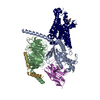+Search query
-Structure paper
| Title | Structures of the ADGRG2-G complex in apo and ligand-bound forms. |
|---|---|
| Journal, issue, pages | Nat Chem Biol, Vol. 18, Issue 11, Page 1196-1203, Year 2022 |
| Publish date | Aug 18, 2022 |
 Authors Authors | Hui Lin / Peng Xiao / Rui-Qian Bu / Shengchao Guo / Zhao Yang / Daopeng Yuan / Zhong-Liang Zhu / Chuan-Xin Zhang / Qing-Tao He / Chao Zhang / Yu-Qi Ping / Ru-Jia Zhao / Chuan-Shun Ma / Chang-Hao Liu / Xiao-Ning Zhang / Dan Jiang / Shaohui Huang / Yue-Tong Xi / Dao-Lai Zhang / Chen-Yang Xue / Bai-Sheng Yang / Jian-Yuan Li / Hao-Cheng Lin / Xu-Hui Zeng / Han Zhao / Wen-Ming Xu / Fan Yi / Zhongmin Liu / Jin-Peng Sun / Xiao Yu /  |
| PubMed Abstract | Adhesion G protein-coupled receptors are elusive in terms of their structural information and ligands. Here, we solved the cryogenic-electron microscopy (cryo-EM) structure of apo-ADGRG2, an ...Adhesion G protein-coupled receptors are elusive in terms of their structural information and ligands. Here, we solved the cryogenic-electron microscopy (cryo-EM) structure of apo-ADGRG2, an essential membrane receptor for maintaining male fertility, in complex with a G trimer. Whereas the formations of two kinks were determinants of the active state, identification of a potential ligand-binding pocket in ADGRG2 facilitated the screening and identification of dehydroepiandrosterone (DHEA), dehydroepiandrosterone sulfate and deoxycorticosterone as potential ligands of ADGRG2. The cryo-EM structures of DHEA-ADGRG2-G provided interaction details for DHEA within the seven transmembrane domains of ADGRG2. Collectively, our data provide a structural basis for the activation and signaling of ADGRG2, as well as characterization of steroid hormones as ADGRG2 ligands, which might be used as useful tools for further functional studies of the orphan ADGRG2. |
 External links External links |  Nat Chem Biol / Nat Chem Biol /  PubMed:35982227 PubMed:35982227 |
| Methods | EM (single particle) |
| Resolution | 2.4 - 2.9 Å |
| Structure data | EMDB-33248, PDB-7xkd: EMDB-33249, PDB-7xke: EMDB-33250, PDB-7xkf: |
| Chemicals |  ChemComp-AND:  ChemComp-HOH: |
| Source |
|
 Keywords Keywords |  MEMBRANE PROTEIN / ADGRG2 / MEMBRANE PROTEIN / ADGRG2 /  GPCR / GPCR /  complex complex |
 Movie
Movie Controller
Controller Structure viewers
Structure viewers About Yorodumi Papers
About Yorodumi Papers











